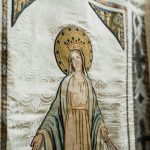You’ll find tapestry and brocade differ mainly in texture, weave, and use. Tapestry is thick, woven with wool or cotton, showing detailed scenes and great durability for wall hangings or upholstery. Brocade, made with silk and metallic threads, offers shiny, raised patterns ideal for elegant clothing or drapes but needs more delicate care. Each fabric brings unique style and function to your project. Keep exploring to see which fits your needs best.
Table of Contents
Key Takeaways
- Tapestry is a plain weave fabric used for detailed pictorial wall hangings, while brocade is a complex weave featuring raised, ornamental patterns.
- Tapestry uses thick wool or cotton threads for durability, whereas brocade employs fine silk and metallic threads for a luxurious, shiny finish.
- Tapestry often depicts historical or mythological scenes, contrasting with brocade’s symmetrical, decorative motifs symbolizing wealth and status.
- Tapestry is ideal for durable home decor like upholstery and wall art, while brocade suits elegant apparel and decorative drapes.
- Tapestry offers a rustic, classical look and is more durable, while brocade requires delicate care but provides opulent texture and light reflection.
Historical Origins of Tapestry and Brocade
Although both tapestry and brocade have decorated walls and garments for centuries, their origins tell different stories.
When you explore tapestry, you’ll find it began as a practical art form in medieval Europe, designed to insulate and beautify castle walls. The scenes often depicted historical events or mythology, reflecting the culture and values of the time.
Tapestry originated in medieval Europe as a practical art form to insulate and decorate castle walls.
Brocade, on the other hand, traces its roots back to ancient China and the Byzantine Empire, where it was prized for luxury and status. You’ll notice brocade’s rich patterns and metallic threads symbolized wealth and power, making it a favored fabric for nobility.
Understanding these origins helps you appreciate how each textile evolved with unique cultural significance, influencing fashion and décor through history.
Weaving Techniques and Construction
When you explore tapestry and brocade, you’ll notice they use different basic weave structures to create patterns.
You’ll find that pattern creation methods vary, impacting the texture and detail of each fabric.
Pay attention to the types of threads used, as they play a key role in the final look and feel.
Basic Weave Structures
Understanding the basic weave structures is key to appreciating the differences between tapestry and brocade.
When you examine tapestry, you’ll notice it uses a plain weave where the weft threads pass over and under the warp threads in a simple, straightforward pattern. This technique allows you to create detailed images by changing colors as you weave.
Brocade, on the other hand, employs a more complex weave, often a satin or twill base, with additional supplementary weft threads woven in to create raised patterns. You’ll find brocade’s structure richer and more textured because of these extra threads, making the fabric heavier and more luxurious.
Pattern Creation Methods
The distinct weave structures set the stage for how patterns come to life in tapestry and brocade.
In tapestry, you create patterns by hand-weaving colored weft threads over and under the warp threads, allowing you to craft intricate, pictorial designs directly onto the fabric. This method lets you control every detail, producing detailed images with a painterly quality.
Brocade, on the other hand, uses a jacquard loom to weave the pattern into the fabric by adding supplementary weft threads that float on the surface, creating raised, decorative motifs. You rely on mechanical precision in brocade, which enables consistent repetition of complex designs with a rich, textured effect.
Understanding these distinct construction techniques helps you appreciate the unique artistry behind each fabric’s patterned beauty.
Thread Types Used
Although tapestry and brocade both rely on thread to bring their designs to life, the types of threads they use differ markedly.
In tapestry, you’ll mostly find wool or cotton threads, which offer durability and matte finishes. Sometimes, artisans blend in silk for added softness or subtle sheen. The threads are thick and sturdy, allowing you to see each individual strand in the finished piece.
Brocade, on the other hand, uses finer, more luxurious threads like silk, metallic gold, or silver. These threads are thinner and shinier, creating that signature rich and reflective surface.
When you handle these fabrics, tapestry feels more textured and robust, while brocade feels smooth and ornate, all thanks to the distinct threads chosen during weaving.
Design and Pattern Characteristics
Patterns play a crucial role in distinguishing tapestry from brocade, and you’ll notice that each fabric tells a different visual story.
When you look closely, tapestry designs often feature elaborate scenes or pictorial representations, woven with intricate detail. Brocade, on the other hand, typically showcases repeating motifs that emphasize luxury and elegance.
Here are three key design characteristics to help you tell them apart:
- Tapestry: Detailed, narrative images like landscapes or historical scenes.
- Brocade: Symmetrical, ornamental patterns often featuring floral or geometric shapes.
- Texture and Depth: Tapestry has a flat woven appearance, while brocade’s raised patterns provide a tactile, embossed effect.
Common Materials Used
Understanding the materials behind tapestry and brocade can help you appreciate their unique qualities even more.
Tapestries traditionally use wool or cotton as their base fibers, thanks to their durability and ease of dyeing. You’ll often find silk threads woven in for added detail and sheen.
Brocade, on the other hand, typically incorporates silk as its primary material, lending it a luxurious feel. Metallic threads like gold and silver are also common in brocade, enhancing its ornate patterns and giving it a rich texture.
While tapestries lean toward natural, sturdy fibers for large-scale artwork, brocade favors finer, more delicate materials to highlight intricate designs.
Knowing these material differences helps you see why each fabric serves distinct purposes and evokes different visual and tactile experiences.
Typical Uses and Applications
You’ll find tapestries mostly gracing walls and adding texture to home decor, while brocade often shines in apparel and fashion with its rich patterns.
Both fabrics carry deep historical and cultural significance that influences their modern uses.
Let’s explore how these characteristics shape their typical applications today.
Home Decor Applications
When choosing fabrics for your home decor, both tapestry and brocade offer unique advantages that can elevate your space. Tapestry’s rich patterns and durability make it ideal for statement pieces, while brocade’s intricate, shiny designs add a touch of elegance and luxury.
Here are three ways you can use these fabrics at home:
- Upholstery: Use tapestry for sofas or armchairs to introduce bold, artistic flair, or choose brocade for accent chairs that demand attention.
- Drapery: Brocade’s sheen and texture create dramatic, sophisticated curtains, whereas tapestry provides a cozy, textured backdrop.
- Decorative Accents: Both fabrics work beautifully for throw pillows or wall hangings, adding depth and interest to your rooms.
Apparel and Fashion Uses
Fashion designers often turn to tapestry and brocade to make bold, luxurious statements in apparel. You’ll find brocade used in evening gowns, jackets, and suits because of its rich texture and intricate patterns that add elegance and sophistication. It’s perfect for creating standout pieces that demand attention.
Tapestry, on the other hand, is less common in everyday wear due to its heavier weight but shines in statement coats, capes, and historical-inspired costumes where durability and elaborate designs matter.
When you choose brocade, you get a fabric that’s flexible enough for tailored fits, while tapestry offers a unique, artistic flair for more structured garments. Both fabrics elevate your wardrobe with timeless beauty and a sense of grandeur.
Historical and Cultural Context
Although tapestry and brocade both boast rich histories, they served distinct roles in culture and daily life. You’ll find tapestries often used to tell stories or display historical events on walls, while brocade primarily enhanced garments and ceremonial textiles with its elaborate patterns.
Understanding their cultural contexts helps you appreciate their unique significance.
Here’s how they differ historically:
- Tapestries decorated castles and churches, preserving history visually.
- Brocade signified wealth, worn by nobility and clergy in Europe and Asia.
- Tapestries provided insulation and artistic expression, brocade symbolized status and power.
When you recognize these uses, you grasp why tapestry and brocade evolved differently despite their shared opulence.
Durability and Maintenance
Since you want your fabric to last, understanding the durability and maintenance of tapestry and brocade is essential.
Tapestry, woven with thick, sturdy threads, tends to be more durable and resistant to wear. It can handle regular use and cleaning better, making it ideal for upholstery and wall hangings.
On the other hand, brocade, with its delicate silk or synthetic fibers and intricate patterns, requires more careful handling. You’ll need to avoid harsh cleaning methods and minimize exposure to sunlight to prevent fading and fabric damage.
Both fabrics benefit from gentle vacuuming to remove dust, but for stains, professional cleaning is often the safest choice.
Visual and Textural Differences
Understanding how you care for tapestry and brocade naturally leads to appreciating their distinct looks and feels. When you examine these fabrics, you notice clear visual and textural differences that set them apart.
- Visual Complexity: Tapestries display detailed, pictorial scenes with intricate patterns woven directly into the fabric. Brocade, on the other hand, features raised, ornamental motifs often using metallic threads for a shimmering effect.
- Texture: Tapestry feels thicker and more textured due to its dense weaving, while brocade is smoother but with raised patterns that add dimension.
- Color Effects: Brocade typically uses contrasting shiny and matte threads, creating dynamic light play, whereas tapestry colors are more matte and blended, emphasizing depth.
These distinctions help you identify and appreciate each fabric’s unique character.
Choosing Between Tapestry and Brocade for Your Project
How do you decide which fabric suits your project best? Start by considering the purpose.
If you want a durable, decorative piece with detailed imagery, tapestry is your go-to. It’s ideal for wall hangings or upholstery where intricate scenes add charm.
Brocade, on the other hand, offers a luxurious sheen and raised patterns, perfect for formal garments or elegant drapes.
Think about texture and maintenance—tapestry tends to be thicker and more textured, requiring gentle care, while brocade’s smooth, shiny surface might need delicate handling.
Consider texture and care: tapestry is thick and textured, brocade smooth and delicate.
Also, factor in style: tapestry evokes a classical, rustic feel, whereas brocade leans toward opulence.
Frequently Asked Questions
Can Tapestry or Brocade Fabrics Be Recycled?
You can recycle tapestry and brocade fabrics, but it’s tricky due to their complex fibers and weaving. You’ll want to check local textile recycling programs or consider repurposing them to reduce waste effectively.
Are Tapestry and Brocade Hypoallergenic?
You might not expect it, but tapestry and brocade fabrics aren’t inherently hypoallergenic. If you’ve got sensitive skin, they could irritate you due to their dense weaving and sometimes mixed fibers, so choose carefully!
How Do Tapestry and Brocade Fabrics Respond to Sunlight?
You’ll find both tapestry and brocade can fade or weaken with prolonged sunlight exposure. To keep them vibrant and strong, avoid direct sunlight or use UV-protective window treatments where they’re displayed or used.
Can Tapestry or Brocade Be Machine Washed Safely?
About 60% of delicate fabrics get damaged in machine washing. You shouldn’t machine wash tapestry or brocade; instead, spot clean or dry clean them to preserve their intricate designs and vibrant colors safely.
Do Tapestry and Brocade Fabrics Have Cultural Symbolism?
You’ll find tapestry often symbolizes historical or religious stories, while brocade represents wealth and status in many cultures. Both carry rich cultural meanings, so understanding their origins helps you appreciate their symbolic value fully.
- Tetron Fabric for Marine Applications: Durability and Use Cases - June 18, 2025
- Tetron Fabric for Outdoor Furniture: Weather Resistance and Care - June 18, 2025
- Tetron Fabric for Wall Coverings: Style and Application Tips - June 18, 2025







